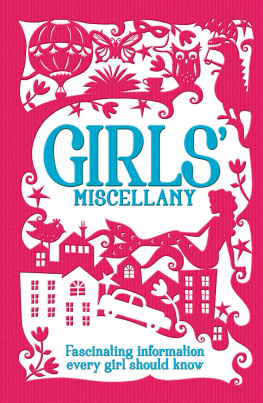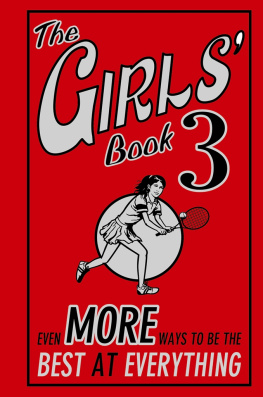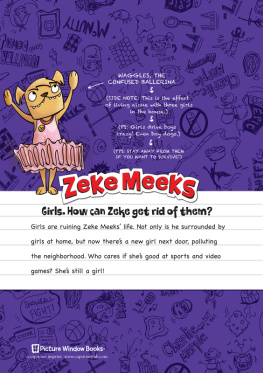Thank you for buying this ebook, published by NYU Press.
Sign up for our e-newsletters to receive information about forthcoming books, special discounts, and more!
Sign Up!
About NYU Press
A publisher of original scholarship since its founding in 1916, New York University Press Produces more than 100 new books each year, with a backlist of 3,000 titles in print. Working across the humanities and social sciences, NYU Press has award-winning lists in sociology, law, cultural and American studies, religion, American history, anthropology, politics, criminology, media and communication, literary studies, and psychology.
delinquents and Debutantes
delinquents and Debutantes
Twentieth-Century American Girls Cultures
edited by
Sherrie A. Inness

NEW YORK UNIVERSITY PRESS
New York and London
1998 by New York University
All rights reserved
Library of Congress Cataloging-in-Publication Data
Delinquents and debutantes : twentieth-century American girls
cultures / edited by Sherrie A. Inness.
p. cm.
Includes index.
ISBN 0-8147-3764-1 (clothbound : acid-free paper)
ISBN 0-8147-3765-X (pbk.: acid-free paper)
1. GirlsUnited StatesHistory20th century. 2. GirlsUnited
StatesSocial conditions. 3. Girls in popular cultureUnited States
History20th century. I. Inness, Sherrie A.
HQ777. D39 1998
305.23ddc21 98-9047
CIP
New York University Press books are printed on acid-free paper, and their binding materials are chosen for strength and durability.
Manufactured in the United States of America
10 9 8 7 6 5 4 3 2
forCathy Ebelke
Contents
Laureen Tedesco
Mary C. McComb
Miriam Formanek-Brunell
Rachel Devlin
Rhona Justice-Malloy
Kelly Schrum
Sherrie A. Inness
Jennifer Scanlon
9 The Flapper and the Chaperone: Cultural
Constructions of Identity and Heterosexual Politics among Adolescent Mexican American Women,
19201950
Vicki L. Ruiz
Melinda L.de Jess
Julia D. Gardner
Angela E. Hubler
Mary Celeste Kearney
Acknowledgments
First on my list of people to thank would have to be all those who contributed to this collection. Their unstinting efforts have made this anthology possible. I could not have asked for a more thoughtful group of scholars with whom to work. They have made editing this collection a pleasure. I would also like to thank those who have read drafts of essays included in this collection, including Kathryn M. Burton, Ruth Ebelke, Faye Parker Flavin, Julie Inness, Michele Lloyd, and Diana Royer. Their criticism helped to tighten up the entire collection.
I would like to thank my friends, among them Alice Adams, Martina Barash, Carolyn Butler Palmer, Kate Johnson, Eric Palmer, Cindy Reu-ther, Judith Russo, Kathryn Shevelow, and Wendy W. Walters. They provided support throughout this anthologys production. I would also like to thank my colleagues at Miami University for their friendship. They help to make the school a rich intellectual environment that furthers all my scholarship. Finally, Jennifer Hammer and her colleagues at New York University Press were a pleasure to work with. Their expertise did much to help improve this collection.
My research has benefited from a number of scholars in childrens literature and girls culture, including Kathleen Chamberlain, Miriam Formanek-Brunell, Jerry Griswold, Peter Hunt, Deidre Johnson, Sally Mitchell, Claudia Nelson, and Lynne Vallone. These are a few of the many who make the study of girls literature and culture a particularly vibrant area today.
Thanks must be reserved for my mother, father, and sister, who provided a much needed support network throughout the process of the editing of this collection. Their encouragement sustained me as I dealt with a broken kneecap and a car accident while working on this anthology. Cathy Ebelke deserves special appreciation as the greatest cousin anyone is likely to ever have. I dedicate this book to her in gratitute for her being a friend and role model to me.
For permission to include revised versions of previously published work, I wish to acknowledge the following journal and books: Rachel Devlin, Female Juvenile Delinquency and the Problem of Sexual Authority in America. Yale Journal of Law and the Humanities 9.1 (1997): 14782; Jennifer Scanlon, Boys-R-Us: Board Games and the Socialization of Young Adolescent Girls. Images of the Child. Ed. Harry Eiss. Bowling Green: Bowling Green State University Popular Press, 1994. 10314; Vicki L. Ruiz, The Flapper and the Chaperone. Out of the Shadows: A History of Mexican American Women in the United States, 19001990. New York: Oxford University Press, 1997.
Introduction
In many ways, girls are inconsequential. Due to their youth and gender, girls are granted less social status than men and boys. They are relegated to an inferior place in American society because of the strength of the cultural stereotype that girls and their culture are insipid and insignificant, unworthy of close attention. Even in Toyland, who gets to deal with serious issues, G.I. Joe or Barbie? G.I. Joe confronts his enemies with a hand grenade; Barbie, presumably, whips out her blow dryer. G.I. Joe is concerned with life and death and war, while Barbies main interest is what color bikini to wear to the beach.
American societys disparaging attitude toward girls culture is also apparent in higher education. Although girls culture is receiving increased attention, an English major can graduate without ever having read a book written for an audience of girls. A history major can graduate without knowing anything about the culture of girls in the United States over the past centuries. A sociology or anthropology major can get a degree without considering the place of girls in a culture. In graduate school, the situation is little different. The new Ph.D. in American Studies probably took no classes that considered girls culture. The holder of a doctorate in English probably did not write a dissertation on the place of girls reading in girls culture. The belief that girls culture is no culture at all proves to be remarkably tenacious, as does the belief that studying girls culture lacks the importance and significance of studying a weightier issue, such as the development of the American political system or the reasons women continue to be economically disadvantaged in our society.
An anthology such as this one is especially needed because scholarly work on girls culture has been insufficient. For much of this century and
This situation is beginning to change. In the late 1980s and 1990s, a number of scholars, many influenced by feminism and its tenets, have introduced gender into their work and acknowledged the importance of studying the previously trivialized culture of girls. Over the last decade, interest in girls culture has grown, resulting in a number of new works that address girls culture in insightful ways. What these works do is bring the same careful and rigorous scholarship to girls culture that earlier scholars interested in gender issues brought to womens culture. The essays in this anthology will broaden the dialogue about girls culture further, making a new group of readers recognize the importance of considering girls as well as women when trying to understand the construction of U.S. culture.
Next page











